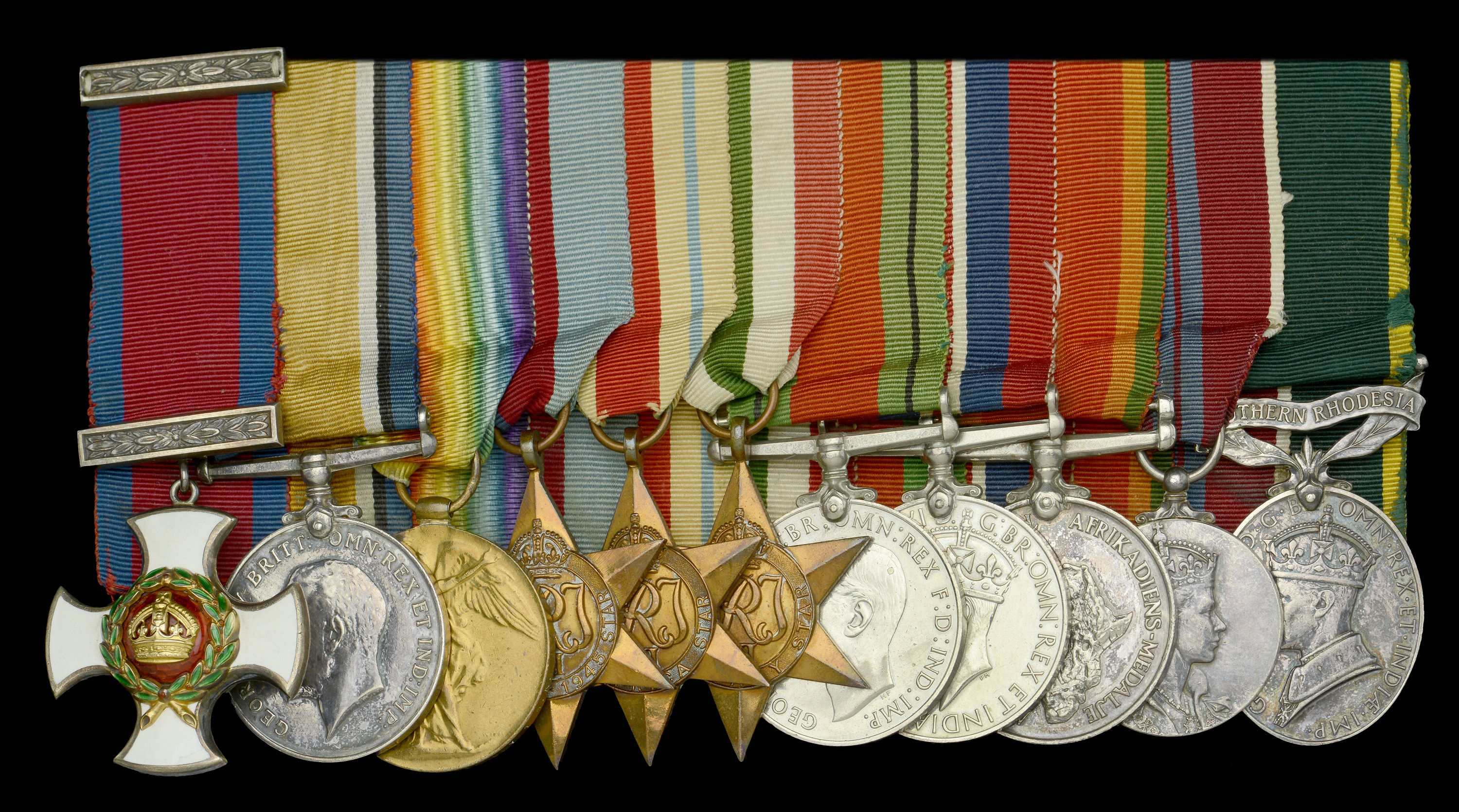A Second War ‘Italian Operations’ D.S.O. group of eleven awarded to Sherman Tank Commander Major C. V. King, Prince Alfred’s Guard and Southern Rhodesian Forces, late Royal Navy, for his gallantry during the crossing of the Finale in April 1945; he had previously been wounded by shell fire on 3 June 1944 Distinguished Service Order, G.VI.R., silver-gilt and enamel, reverse officially dated 1945, with integral top riband bar; British War and Victory Medals (J.59714 C. V. King. Boy. 1. R.N.); 1939-45 Star; Africa Star; Italy Star; Defence and War Medals 1939-45, these all unnamed as issued; Africa Service Medal (SR.597707 C. V. King.) Coronation 1953, unnamed as issued; Efficiency Medal, G.VI.R., 1st issue, Southern Rhodesia (Major C. V. King D.S.O.) re-engraved naming, mounted court-style as worn, generally very fine and better (11) £1,800-£2,200 --- D.S.O. London Gazette 23 August 1945: ‘In recognition of gallant and distinguished services in Italy.’ The original Recommendation, for an Immediate Military Cross (subsequently upgraded to a D.S.O.), dated 11 May 1945, states: ‘For conspicuous gallantry, boldness, and devotion to duty. On the night of 22-23 April 1945, Major C. V. King was in command of a squadron of tanks ordered to support the Royal Durban Light Infantry in securing the road and bridge intersection at Finale (Map Ref. 866857). This objective proved to be a strongly held enemy rear guard position. Soon after darkness this strongly held position was overrun and the tanks had driven a wedge right into the centre against heavy opposition. Despite the darkness and lack of manoeuvre, owing to the impossibility of deploying the tanks off the road, Major King pressed his tanks forward through enemy infantry armed with bazookas, he himself moving with the leading troop. From here he was able to effectively engage an animal drawn convoy protected by enemy tanks. By this time the animal convoy had been cut in two, the leading tank began engaging Major King and the leading troop from two sides, resulting in two of our tanks being knocked out. The extent of the damage and loss off equipment caused to the enemy was evident the following morning when some fifty to sixty vehicles were found to be destroyed. During the confused fighting that lasted till 0300 hrs, Major King remained with his leading tanks, and his coolness and imperturbable courage during intensive tank and shellfire was an inspiration to his men, and an outstanding example of zeal and devotion to duty. He displayed an exceptional degree of tenacious courage and resourceful determination under the most adverse tank conditions. His personal bravery and leadership could not be surpassed.’ Cecil Vincent King was born on Robben Island, Cape Town, on 3 August 1900 and joined the Royal Navy as a Boy Second Class on 7 August 1916, serving initially in H.M.S. Hyacinth and H.M.S. Impregnable. He was advanced Boy First Class on 26 February 1917, and was promoted to Able Seaman on 3 April 1919. He was invalided out of the service, suffering from Rheumatism, on 10 December 1919. Having moved to Southern Rhodesia King saw early service in North Africa during the Second World War, before being assigned to the Prince Alfred’s Guard, with who he saw extensive service in Italy with the rank of Major, and was wounded on 3 June 1944 when his foot was crushed by a lump of flying earth thrown up by an exploding shell. For his services as a Sherman tank commander at the crossing of the Finale in April 1945 he was awarded the Distinguished Service Order; Neil Orpen’s Victory in Italy gives the following coda to his D.S.O. action: ‘Strewn among the wreckage of more than 60 enemy vehicles lay the corpses of Germans who had tried to hold open the line of retreat. The carcasses of horses and oxen killed in the night’s hail of crossfire sprawled among shattered lorries, carts, semi-tracked vehicles, guns, limbers and piles of wrecked enemy equipment of every conceivable kind. At the crossing point over the canal about 200 metres from the river, smashed carts, dead oxen, mules, and horses were so entangled with trucks and knocked-out assault guns and tanks that a bulldozer was needed to clear the way for the advancing columns. A ground check in the area immediately south-east of Finale showed enemy losses amounting to 51 guns, 17 mortars, 2 tanks, 17 half-tracks, 100 or more motor-drawn vehicles, and more than 150 horse-drawn vehicles.’ During the actual fighting the R.D.L.I. had taken 160 prisoners, and no fewer than 200 enemy dead were found on the battlefield, compared to the R.D.L.I. casualties of just 12 wounded.’





